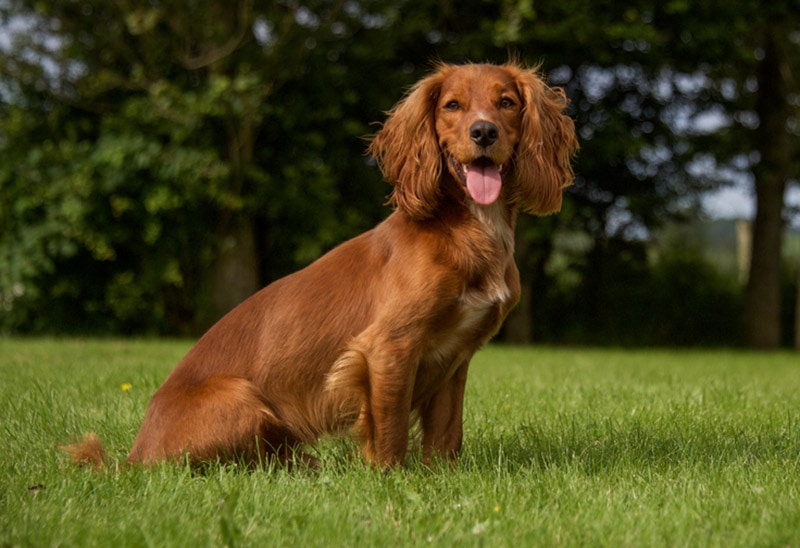Are Cocker Spaniels Good With Cats? Cohabitation Facts & FAQ

Updated on

Click to Skip Ahead
It’s an age-old question: Can cats and dogs coexist peacefully? More specifically, are Cocker Spaniels good with cats? To put it simply, the answer is a resounding yes. Cocker Spaniels are known for their friendly, sociable nature, which makes them highly compatible with other pets—including cats. This is good news!
But, of course, this is just the tip of the iceberg. Let’s take a closer look at the dynamics of this furry friendship and explore the various factors that can influence their relationship.
Understanding Cocker Spaniels
Cocker Spaniels are part of the sporting group and were originally bred for hunting. However, they’ve since become excellent companion dogs, owing to their affectionate and friendly disposition. Cocker Spaniels are known for their intelligence, their trainable nature, and their love for playing and socializing.

Their Temperament
One of the primary reasons why Cocker Spaniels get along well with cats is their temperament. They’re gentle, cheerful, and have an intrinsic eagerness to please their humans. These traits also make them patient and tolerant, even when dealing with sometimes aloof and independent cats.
Their Energy Levels
Cocker Spaniels have moderate to high energy levels and love to play. Having a cat, especially a playful one, can provide an excellent playmate for them. Cats and Cocker Spaniels can engage in games that provide physical stimulation and mental enrichment for both parties, which is a great bonus.

 How Do You Introduce a Cocker Spaniel to a Cat?
How Do You Introduce a Cocker Spaniel to a Cat?
When introducing a Cocker Spaniel to a cat, there are various factors to consider that might influence their initial interactions. These factors include their respective ages, the cat’s previous experiences with dogs, and the dog’s prior encounters with cats.
Understanding these elements can guide the process, ensuring a smooth transition for both pets as they adjust to each other’s presence.
The Value of Early Interaction
In many instances, when a Cocker Spaniel and a cat are introduced to each other at a young age, they are more likely to establish a strong bond.
This happens because young animals—whether kittens or puppies—are usually more open, adaptable, and accepting of new experiences. They tend to be more curious, less cautious, and more forgiving of each other’s social blunders.
This is an opportune time for them to learn each other’s body language and develop mutual respect and understanding. Over time, as they play, eat, and even nap together, they can form a close, enduring bond that persists into their adult years.

The Bonding Process
As part of the introduction process, the bonding phase may take a bit more time and patience. It’s important to remember that adult pets often have established behaviors and may need more time to adjust to each other.
To facilitate a harmonious relationship, start with a gradual introduction process. Initially, they should be allowed to observe each other from a safe distance, perhaps with a baby gate separating them. This arrangement allows them to sniff, observe, and get used to each other’s presence without the risk of a physical confrontation.
As they show signs of relaxation and acceptance, gradually increase their time together under supervision. Always remember that patience is key. Some pets may take weeks or even months to fully accept each other, and that’s perfectly okay!
The Crucial Role of Training in Interspecies Cohabitation
Training is a critical aspect of fostering a good relationship between a Cocker Spaniel and a cat. The trainable nature of Cocker Spaniels makes this process relatively straightforward and successful.

Establishing Boundaries: The Key to Respectful Coexistence
A crucial part of this training involves establishing boundaries. Cocker Spaniels need to be taught to respect the cat’s space. Simple commands like “leave it” or “stay” can be incredibly useful in helping the dog understand when to give the cat some space.
Cats, by nature, value their independence and often need a quiet, safe space to retreat to when they want some alone time. Ensuring that the cat has such a safe space, which the dog understands to be off-limits, can significantly reduce potential conflicts.
Reinforcing Positive Behavior: The Power of Rewards
Positive reinforcement is a powerful tool to encourage positive interactions between a Cocker Spaniel and a cat. Rewarding the dog for calm and respectful behavior around the cat reinforces the notion that this is the correct and expected way to behave.
Over time, these positive behaviors become ingrained, making peaceful cohabitation second nature to them.

Keeping Your Dog Healthy and Safe
Witnessing our pets getting along can be heartwarming. However, the health and safety of the pets should always remain a top priority. Here are some basic guiding principles to follow in the care of your pets:
Regular Vet Visits
Ensure regular vet visits for both the Cocker Spaniel and the cat. Routine check-ups can help prevent any potential health issues and ensure that your pets are in the best shape. Moreover, your vet can answer any questions or concerns you might have. So don’t hesitate to act if you’re unsure about something. Prevention is always better than treatment!

Balanced Diet and Exercise
Maintaining a balanced diet and ensuring ample exercise are vital for both pets. Cocker Spaniels, being the energetic dogs that they are, need regular physical activity to keep them healthy. Similarly, playtime can help keep cats mentally stimulated and physically active.
Monitor Interactions
Monitoring the interactions between your Cocker Spaniel and your cat, especially in the initial stages, is crucial. Observing their body language can provide valuable insights into their feelings and attitudes toward each other.
By intervening when necessary, potential misunderstandings or conflicts can be prevented, ensuring the peaceful and happy cohabitation of your dog and cat.
Conclusion
While every pet is unique, and there are no absolute guarantees, Cocker Spaniels are generally excellent companions for cats. Their friendly, adaptable nature and their trainability make them a great match for our feline friends.
With patience, supervision, and proper training, these two can indeed become the best of friends. Here’s to fostering beautiful friendships between cats and Cocker Spaniels!
Featured Image Credit: Jeanette Virginia Goh, Shutterstock

 How Do You Introduce a Cocker Spaniel to a Cat?
How Do You Introduce a Cocker Spaniel to a Cat?








